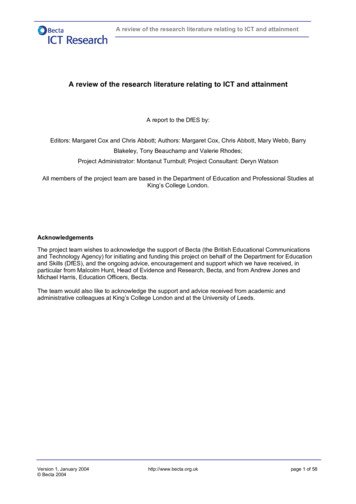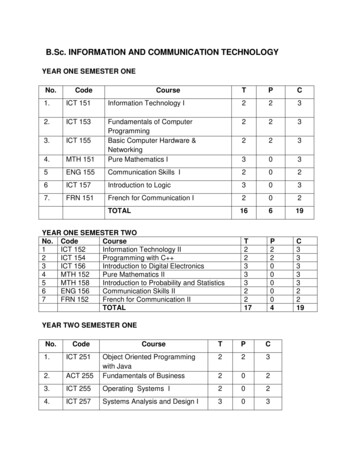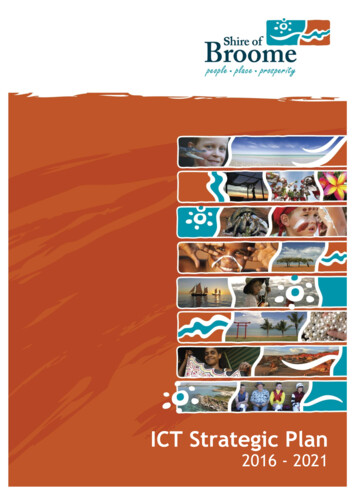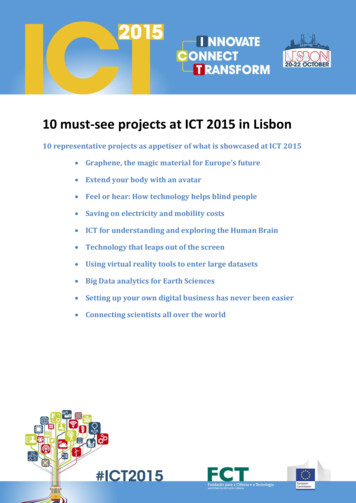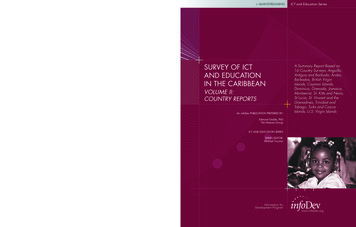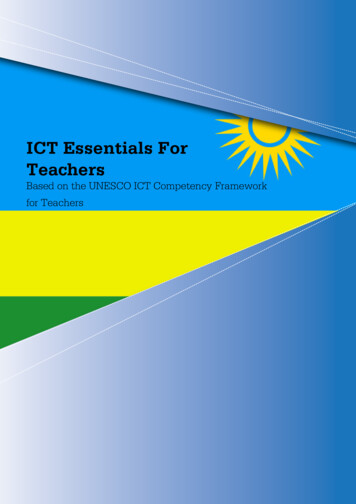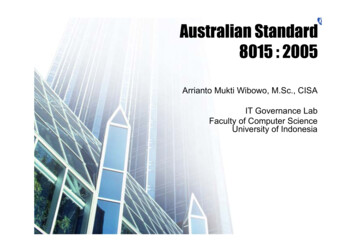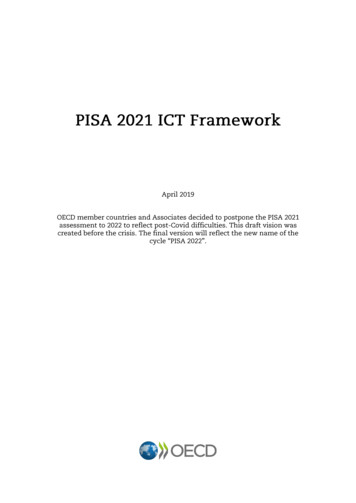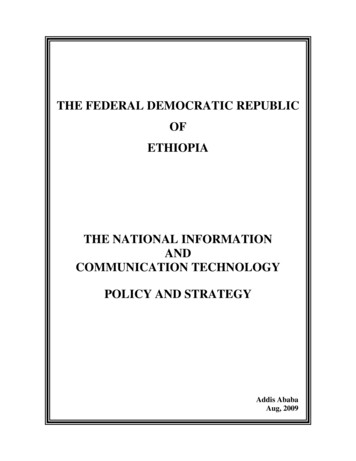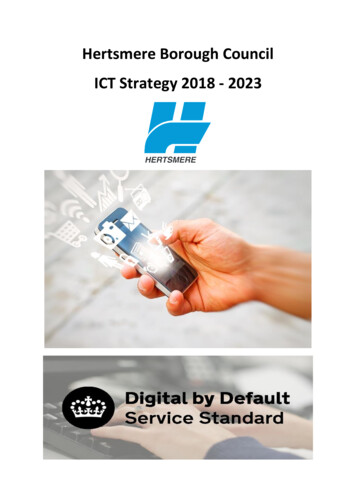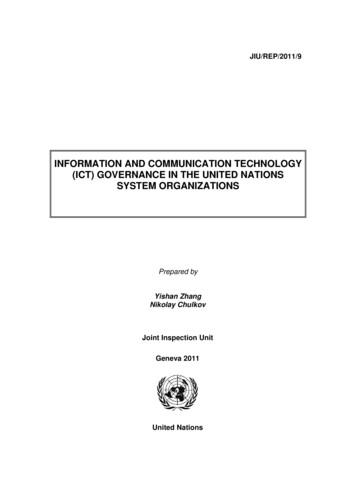
Transcription
JIU/REP/2011/9INFORMATION AND COMMUNICATION TECHNOLOGY(ICT) GOVERNANCE IN THE UNITED NATIONSSYSTEM ORGANIZATIONSPrepared byYishan ZhangNikolay ChulkovJoint Inspection UnitGeneva 2011United Nations
JIU/REP/2011/9Original:ENGLISHINFORMATION AND COMMUNICATION TECHNOLOGY(ICT) GOVERNANCE IN THE UNITED NATIONSSYSTEM ORGANIZATIONSPrepared byYishan ZhangNikolay ChulkovJoint Inspection UnitUnited Nations, Geneva 2011
iiiEXECUTIVE SUMMARYInformation and communication technology (ICT) governance inUnited Nations system organizationsJIU/REP/2011/9ObjectiveIn recent years, the world has witnessed the rapid growth and ever-increasingimportance of information and communication technologies (ICT). ICT hasbecome a dynamic, strategic and indispensable asset of an organization in theachievement of its mission and goals.How to harness the power of ICT effectively? How to maximize investment inICT? How to mitigate the risks associated with ICT? All these questions point toand rely on one parameter: ICT governance.The objective of the review is to conduct a comparative analysis of the differentICT governance frameworks, practices and processes in the various United Nationssystem organizations with a view to identifying best practices and lessons learned,and thereby promote effective ICT governance.Main findings and conclusionsThe report contains 11 recommendations, one of which is addressed to thelegislative bodies of the United Nations system organizations, nine to theirexecutive heads and one to the Secretary-General of the United Nations in hiscapacity as Chairman of the United Nations System Chief Executives Board forCoordination (CEB).In the Inspectors’ opinion, an effective ICT governance framework should includethe following: A well-functioning ICT governance committee or equivalent, which shouldbe composed of senior managers from all parts of the organizations andmeet regularly, and whose functioning is reviewed periodically(recommendations 2 and 3); Strong leadership over the ICT governance infrastructure by the executivemanagement, preferably at the level of the deputy head of the organizations(recommendation 1 ); An appropriate Chief Information Officer (CIO) or equivalent in a seniorlevel post with overall responsibilities and authority and access to theexecutive management (recommendation 4); A full-fledged corporate ICT strategy aligned to the organizations’ businessneeds and priorities, and yielding true value of the ICT investment, which
ivshould be reviewed and updated periodically (recommendations 5 and 7); A well-established mechanism to monitor the implementation of the ICTstrategy (recommendation 8); Strengthened efforts to track ICT costs in the organizations and conductpost-implementation reviews of major ICT investments so as to facilitatestrategic decision-making, cost-effectiveness, accountability andtransparency (recommendations 9 and 10).Recommendation for consideration by the legislative organsRecommendation 6The legislative bodies of the United Nations system organizations shouldrequest the executive heads to present the corporate ICT strategies to memberStates for their information and support.Recommendation for consideration by the CEBRecommendation 11The Secretary-General, in his capacity as Chairman of the CEB, shouldstreamline the Board’s ICT Network by identifying and focusing on commonICT issues and providing clear guidance to the network in order to improvecooperation and coordination among the United Nations systemorganizations.
vCONTENTSChapterEXECUTIVE SUMMARY .ABBREVIATIONS .I. INTRODUCTION .Paragraphs Pageiiivi1-131A Background, objectives, scope and methodology.1-131II. GOVERNANCE .A. Definition of ICT governance.B. Importance of ICT governance .C. Basic ICT governance structures and frameworks .D. ICT governance committees .1. Composition of the ICT governance committee .2. Leadership of the ICT governance committee .3. Terms of reference of the ICT governancecommittee .4. Effectiveness of the ICT governance committee .E. Chief Information Officer (CIO) .III. STRATEGY .A. Preparation, endorsement and update of the ICTstrategy.B. Alignment of the ICT strategy with the organizations’strategic plans .C. Implementation and monitoring of the ICT strategy .IV. RESOURCES AND OTHER ICT ISSUES 5-5859-7374-948111477-851486-891690-9495-1291618A. Transparency of ICT costs.95-10118B. ICT investments .C. ICT performance and oversight .102-107108-1161920D. ICT risk management.E. IT security .F. ICT business continuity and disaster recovery .V. SYSTEM-WIDE ICT COOPERATION .117-121122-126127-129130-13421222224AnnexesI. ICT governance committees, or equivalent, in the UnitedNations system organizationsII. ICT strategies in the United Nations system organizationsIII. Chief Information Officers (CIO), or equivalent, in theUnited Nations system organizationsIV. Overview of action to be taken by participatingorganizations on JIU recommendations25262730
UNICEFUNIDOUNODCUNRWAUNWTOUPUWFPWHOWIPOWMOUnited Nations System Chief Executives Board for CoordinationCommittee on Business and Information TechnologyControl Objectives for Information and Related TechnologyEnterprise Portfolio ManagementEnterprise Risk ManagementEnterprise Resource PlanningEuropean UnionFood and Agriculture Organization of the United NationsHigh-Level Committee on ManagementInternational Atomic Energy AgencyInternational Civil Aviation OrganizationInformation and Communication TechnologyICT Network of the United Nations System under the CEBInternational Fund for Agricultural DevelopmentInternational Labour OrganizationInternational Maritime OrganizationInformation Systems Audit and Control AssociationInternational Public Sector Accounting StandardsInformation TechnologyIT Governance InstituteInformation Technology Infrastructure LibraryInternational Telecommunications UnionJoint Inspection UnitOffice of the High Commissioner for Human RightsOrganisation for Economic Co-operation and DevelopmentOrganization for Security and Co-operationUnited Nations Conference on Trade and DevelopmentUnited Nations Development ProgrammeUnited Nations Economic Commission for EuropeUnited Nations Environment ProgrammeUnited Nations Educational, Scientific and Cultural OrganizationUnited Nations Population FundOffice of the United Nations High Commissioner for RefugeesUnited Nations International Computing CentreUnited Nations Children’s FundUnited Nations Industrial Development OrganizationUnited Nations Office on Drugs and CrimeUnited Nations Relief and Works Agency for Palestine Refugees in theNear EastUnited Nations World Tourism OrganizationUniversal Postal UnionWorld Food ProgrammeWorld Health OrganizationWorld Intellectual Property OrganizationWorld Meteorological Organization
1I.A.INTRODUCTIONBackground, objectives, scope and methodology1. As part of its programme of work for 2011, the Joint Inspection Unit (JIU), in responseto a suggestion from United Nations Development Programme (UNDP) that was supported bya dozen other United Nations system organizations, conducted a review of “Information andcommunication technology (ICT) governance in the United Nations system organizations.”2. No system-wide review of ICT governance in the United Nations system organizationshas yet been conducted. However, in 2008, the JIU issued two reports 1 which briefly touchedon the topic of ICT governance. The reports stressed the importance of effective ICTgovernance as a critical factor for successful ICT operations in an organization. They alsohighlighted that ICT governance is an issue of critical significance for the United Nationssystem organizations, one which merited further study.3. In his report “Investing in information and communications technology: status report”(A/62/502), the Secretary-General of the United Nations stated that achieving effective ICTgovernance was a major challenge for large, complex and geographically dispersedorganizations. 24. The objective of this review is to conduct a comparative analysis of the different ICTgovernance frameworks, practices and processes in the various United Nations systemorganizations, with a view to identifying best practices and lessons learned and therebypromote effective ICT governance. The key aspects considered included the ICT governancestructures in place; implementation of the organization’s ICT strategy; strategic alignment ofICT with the organization’s business objectives and mandate; ICT resource management,decision-making process and investment; ICT performance and risk management, includingICT security and business continuity/disaster recovery. In addition to ICT governance withinthe organizations, the review also examined ICT governance at the United Nations systemwide level, notably coordination and cooperation among the United Nations systemorganizations in the area of ICT, for example, through the ICT Network (ICTN) of the UnitedNations System Chief Executives Board for Coordination (CEB) and its High-LevelCommittee on Management (HLCM).5. In the preparation of the report, the Inspectors took into consideration, as appropriate,internationally accepted ICT governance standards and methodologies considered industriesbest practice, such as the Control Objectives for Information and Related Technology(COBIT), developed by the Information Systems Audit and Control Association (ISACA) andits affiliated IT Governance Institute (ITGI), the Information Technology InfrastructureLibrary (ITIL), developed by the Government of the United Kingdom, Prince2methodologies, ISO 20000 and 27000 standards for IT security, as well as ISO standardISO/IEC 38500-2008 for corporate governance of information technology.6. In accordance with JIU internal standards and guidelines and its internal workingprocedures, the methodology used to prepare this report included a preliminary review,questionnaires, interviews and an in-depth analysis. Interviews were conducted in Geneva,New York, Paris, Rome, Vienna and Washington DC with officials of most JIU participating12See JIU/REP/2008/5, Review of ICT hosting services in the UN system organizations, andJIU/REP/2008/6, Review of management of internet websites in the UN system organizations; alsoJIU/REP/2002/9, Information management in the United Nations systems organizations.A/62/502, para. 2.
2organizations, as well as the CEB Secretariat. Consultation and dialogue were sought with allmain stakeholders, including senior and executive managers, ICT officials, users as well asoversight officials.7. The report team also participated, upon invitation, in the 16th and 17th session of theCEB ICT Network (ICTN), held in April and October 2011 respectively, and discussed majorissues concerning ICT governance with participants.8. Other international organizations and financial institutions, such as the European Union(EU), the International Fund for Agricultural Development (IFAD), the InternationalMonetary Fund (IMF), the International Organization for Migration (IOM), the Organisationfor Economic Co-operation and Development (OECD), the Organization for Security and Cooperation (OSCE), and the World Bank were also consulted. Given the wide range of issuescovered, it was not possible to carry out an in-depth review of all of them in each and everyUnited Nations system organization. Therefore, reference is made to organizations inparticular contexts with the sole aim of providing examples.9. Finally, the internal and external auditors of the United Nations system organizationsand their evaluation offices have issued various reports touching on ICT governance. Thosereports, as well as the ongoing discussions and debate at the CEB/HLCM level on pertinentissues were taken into account in the appropriate context.10. As is customary, comments on the draft report were sought from the participatingorganizations and taken into account in the final report.11. In accordance with article 11.2 of the JIU statute, this report was finalized afterconsultation among the Inspectors so as to test its conclusions and recommendations againstthe collective wisdom of the Unit.12. To facilitate the handling of the report and the implementation of its recommendationsand the monitoring thereof, the table in annex IV indicates whether the report is submitted tothe organizations concerned for action or for information. The table identifies therecommendations relevant for each organization and specifies whether a decision by thelegislative body of the organization or action by its executive head is required13. The Inspectors express their appreciation to all who assisted them in the preparation ofthis report, particularly those who participated in the interviews and so willingly shared theirknowledge and expertise.
3II.A.GOVERNANCEDefinition of ICT governance14. ICT governance is a subset discipline and an integral part of corporate governance. 3“ICT governance is the responsibility of executives and the board of directors, and consists ofthe leadership, organisational structures and processes that ensure that the enterprise’s ICTsustains and extends the organisation’s strategies and objectives.” 415. In line with this definition, the Secretary-General, in a recent report, stated as follows:“The principles and processes associated with ICT decision-making and its underlyingorganizational structures come together under the broad concept of ICT governance. The ICTmanagement framework clarifies how decisions are made, who provides inputs for thedecisions, who is accountable and how ICT activities are coordinated within the Secretariatand ensures that key stakeholders take on the appropriate roles and responsibilities to clearlyand effectively guide the management of the Organization’s ICT activities and resources.” 516. According to COBIT, the governance of ICT is the pivot directing ICT endeavours andensuring that ICT performance meets the following objectives: (i) alignment with andrealization of the organization’s mandate and objectives; (ii enablement of the organization byexploiting opportunities and maximizing benefits; (iii) responsible use of ICT resources; and(iv) appropriate management of ICT-related risks. 6B.Importance of ICT governance17. In recent years, the world has witnessed the rapid growth and ever-increasingimportance of ICT. It is hard to imagine an organization operating successfully in the 21stcentury without a strong ICT infrastructure.18. The role of ICT has evolved over the past decades from a supporting, back-officefunction to a key function, enabler and driving force for organizations. It has become adynamic and strategic asset of an organization for the successful achievement of its missionand goals. ICT is essential to managing transactions, information and knowledge necessary toachieve and sustain an organization’s mandate and goals. Hence, organizations are becomingincreasingly dependant on a well-functioning ICT infrastructure.19. At the same time, the expenditure and costs for ICT have grown significantly over thepast years. The approximate total ICT costs in the United Nations system organizations rangefrom about 2 to about 13 per cent of the total annual budget of the organizations over 2009and 2010, with most organizations spending about 4 to 7 per cent of the total annual budget3456The International Organization for Standardization (ISO) defines corporate governance of IT inparagraph 1.6.3 of its standard ISO/IEC 38500-2008, Corporate governance of informationtechnology, as the system by which the current and future use of IT is directed and controlled.Corporate governance of IT involves evaluating and directing the use of IT to support theorganization and monitoring this use to achieve plans. It includes the strategy and policies forusing IT within an organization.See ITGI, Board Briefing on IT Governance, 2nd Edition, 2003, pp. 6-11, available cuments/BoardBriefing/26904 Board Briefing final.pdfA/65/491, para. 24.For further information on COBIT, see verview.aspx.
4on ICT. 7 Not included in those costs is expenditure for specific ICT initiatives and projects,such as Enterprise Resource Planning (ERP) systems, which, as some organizations observed,may be as high as the annual ICT budgets of the organizations. Total ICT costs at the WorldFood Programme (WFP) were about 3 per cent of the budget in 2009/2010, and at the Officeof the United Nations High Commissioner for Refugees (UNHCR), approximately 3 and 4per cent in 2009 and 2010 respectively. The United Nations Population Fund (UNFPA) spentaround 2 per cent of their budget on ICT during this period, while the International CivilAviation Organization (ICAO) spent about 7 per cent (CAD 2.7 million) of its annual budgeton ICT in 2009-2010, although major ICT projects were funded through additional funds, inthe amount of CAD 640.000 in 2009, and CAD 2.5 million in 2010. The WorldMeteorological Organization (WMO) spent about 3.4 percent (CHF 2.9 million) of its annualbudget on ICT in 2010, while an additional CHF 3.2 million was spent on IPSASimplementation during the period 2008-2011.20. ICT governance is an important factor in generating business value from ICT. A studyon ICT governance was conducted by MIT Sloan School of Management’s Centre forInformation System Research (CISR). The study covered more than 300 enterprises in over20 countries and concluded that IT business value directly results from effective ITgovernance. The research indicated that firms with superior IT governance have at least 20per cent higher profits than firms with poor governance, given the same strategic objectives. 821. Effective ICT governance is a critical factor for successful ICT operation in anorganization; it ensures that the organization’s ICT is aligned to and supports its strategiesand mandate. To this end, the ICT governance mechanism should ensure that the decisionmaking process on ICT direction, strategy and investments are driven by business so as toenable close alignment of ICT with the organization’s business needs. The ICT governancestructure and processes should also guarantee the resolution of cross-cutting priorities andrequirements at an organization-wide level, which is often a challenge in the United Nationssystem organizations which have federated and de-centralized ICT architectures andconcomitant ICT resource allocations.22. Effective ICT governance also contributes to better harmonization and coherence withrespect to ICT security levels, ICT project management methodologies and generally ICTsystems. Finally, an effective ICT governance structure facilitates appropriate awareness ofthe strategic importance of ICT among managers and staff, and promotes ICT as a strategictool and enabler for enhancing organizational effectiveness and efficiency and facilitatingchange management.C.Basic ICT governance structures and frameworks23. There is no single ICT governance formula or framework to suit all the United Nationssystem organizations. Nevertheless, there are agreed common elements that form the basicstructure of an ICT governance framework.24. ICT governance mainly addresses three critical questions: What decisions must be madeto ensure appropriate management and use of ICT? Who should make these decisions? Howwill these decisions be implemented and monitored?78Information based on responses to the questionnaire; the figures indicated are aggregates aimed atpresenting an overview of the situation. They do not allow for specific conclusions to be drawn inrespect of the organizations, bearing in mind the different mandates, structures, activities andoperations of the organizations.See Peter Weill and Jeanne W. Ross, IT Governance, Harvard Business School Press, 2004, p.VIII; the research covered the period 1999-2003.
525. The central element is the ICT governance committee or equivalent, composed ofbusiness managers providing overall guidance and direction on ICT at the organization-widelevel. The committee or board is often supported by a technical committee which providestechnical advice and support. The United Nations organizations 9 and those with regional andfield offices also have local ICT committees in the organizations’ substantive departmentsand/or regional and country offices.26. Most organizations also have one or several working group(s) or task force(s) for certainmajor ICT programmes, for example, the working groups for each of the three strategic ICTprogrammes at the United Nations. 10 Finally, in addition to standing ICT governance bodies,separate ad hoc governance structures are established for major, large-scale and cross-cuttingICT projects, such as enterprise resource planning (ERP) implementation, which maycomprise steering committees, project teams, working groups and task forces at differentlevels, as appropriate.27. The organization’s corporate ICT strategy forms an integral part of the basic ICTgovernance. Further, the CIO, CTO or Head of the ICT department, the ultimate responsibleofficial for ICT in the organization to whom the CIO or equivalent reports to and MemberStates in the legislative bodies, i.e. with respect in deciding on and allocating ICT resourcesthrough the organization’s programme budget preparation process for ICT, play an importantrole in governing the organization’s ICT.28. Given the various structures and mandates of the United Nations system organizations,ICT governance frameworks, including the ICT governance committee or equivalent, varyacross the organizations.D.ICT governance committees29. The great majority of organizations have an ICT governance committee or equivalent inplace. In most organizations, including the United Nations, UNDP, UNFPA, UNHCR,UNICEF, WFP and WMO, the ICT governance committee is a separate body composed ofofficers at the senior and executive levels representing all parts of the organization andchaired by an executive manager. 11 Some organizations, such as UNESCO and ICAO, do nothave separate ICT governance committees, rather their established management committeesdeal with ICT matters in addition to other organizational and managerial issues. At UNIDO,the Committee for Change and Organizational Renewal (CCOR), which was established inFebruary 2010, provides strategic direction and oversight with regard to all changeundertakings in the organization, including all ICT-related issues and governanceframeworks.30. The most crucial role and function of the ICT governance committee is to ensurealignment of ICT with the organization’s business needs. The committee provides a forum91011The ICT structures at OHCHR, UNCTAD, UNEP, UN-Habitat, UNOV, UNODC and UNWRAare governed by the ICT governance framework and the ICT strategy of the United Nations,established by the Office of Information and Communications Technology (OICT) of the UnitedNations Secretariat.These are knowledge management, resource management and infrastructure management.UNDP, UNFPA, UNOPS, UN Women and UNU also have a unique ICT governance mechanism,whereby all Atlas agencies are members of the Inter-Agency Atlas Governance Group (IAAG).The Group meets regularly to review common Atlas-related issues, and it is an important aspect ofICT governance in those organizations where strategic issues impacting the Atlas agencies areescalated to the Executive Sponsor Group which comprises Assistant Secretary-Generals of thethree core Atlas agencies (UNDP, UNFPA and UNOPS).
6and mechanism where business managers from all parts of the organization can meet todiscuss ICT requirements and needs at the organization level; it therefore serves as amechanism for the resolution of competing priorities at that level. This function gainsparticular importance due to the fact that the great majority of organizations have strong decentralized and federated ICT structures, with various ICT units located in their majordepartments and programmes as well as in the organizations’ regional and country offices.Without a central governance body dealing with cross-cutting issues at the corporate level,organizations risk having fragmented, inefficient and ineffective ICT structures.31. At the time of the review, the Food and Agriculture Organization of the United Nations(FAO) and UNESCO were in the process of reforming their ICT governance frameworks. Inthis context, the organizations also reviewed the composition and terms of reference (TOR) oftheir ICT governance committees or equivalent, and some departments had not yet establishedtheir ICT governance committees or they were not fully operational. Following a review of itsICT governance structure, UNDP is currently revising the TOR of its ICT governance body,the ICT Board.32. Therefore, in the Inspectors’ view, the executive heads of FAO 12 and UNESCOshould ensure that their ICT governance committees or equivalent are established andoperational without undue delay, so as to make full use of ICT in sustaining theorganizations’ mandates and objectives.1. Composition of the ICT governance committee33. ICT governance is the responsibility of senior management. The composition andchairmanship of ICT governance committees or equivalent varies across the United Nationssystem organizations. Membership usually includes business managers at different levelsfrom various parts of the organization, including regional and country offices, as appropriate.The committee is chaired by an executive officer, sometimes the deputy executive head of theorganization, in other cases the director of administration or equivalent.34. The CIO or Head of ICT is also represented on the ICT governance committee, as an exofficio member or as secretary of the committee. 13 This ensures that the CIO can provideadministrative and technical support to facilitate the work of the committee; it also ensuresthat the CIO is informed of the committee’s discussions and decisions.35. The Inspectors noted that the composition of the committees in some organizations doesnot ensure adequate representation of business managers from all parts of the organization,including from the various substantive departments and programmes at headquarters and inregional and country offices for organizations with a strong field presence. The Inspectorsalso learned that the committee members are not in all organizations business managers at theappropriate senior level.36. In the Inspectors’ view, it is of utmost importance that all or at least the majorbusiness owners from all the major services of the organization, including the regionaland country offices, as appropriate, are represented in the organization’s ICTgovernance body, so as to ensure an effective ICT governance committee or equivalent,12FAO’s new Information Technology and Knowledge Management Governance Framework wasapproved by its Director-General on July 18th, 2011 and implemented in September 2011.13Practices in the organizations differ: for example at the United Nations and UNHCR, the CIO is anex officio member of the ICT-EC and the UNHCHR ICT Governance Board, respectively; atWFP, the CIO is a member of the MISSC; while at UNDP, the CTO performs the role of secretaryto the UNDP ICT Board.
7as a forum where business owners can discuss and provide direction and guidance onICT at the organization level.37. Furthermore, the members of the committee should be business managers at theappropriate senior level, preferably the most senior level. Only then can they adequatelyrepresent their departments and programmes, with the authority to present and defend theirICT needs and requirements within the committee, thereby allowing the committee to serve asa forum for discussion and decision-making on ICT matters, including the resolution ofcompeting ICT priorities, requirements and needs at the organization level. That would alsoensure that all business managers are regularly updated on ICT issues, as well as on ICTrequirements, the status of major ICT initiatives and investments in the organization.2. Leadership of the ICT governance committee38. The Inspectors believe that an organization’s ICT governance committee should bechaired by an executive manager, preferably a deputy executive head of the organization or anexecutive officer with similar status, function or authority. This would ensure that inputs andviews of the executive management are brought into the discussions and work of the body,and at the same time, executive management will be apprised of and periodically updated onits work, discussions and decisions. This would also contribute to raising awareness at theexecutive management
Information and communication technology (ICT) governance in United Nations system organizations JIU/REP/2011/9 Objective In recent years, the world has witnessed the rapid growth and ever-increasing importance of information and communication technologies (ICT). ICT has become a dynamic, strategic and indispensable asset of an organization in the
